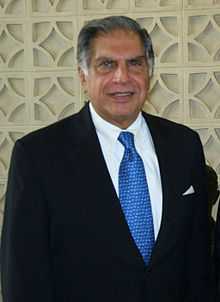Zoroastrianism in India
| ||||||||||
| Total population | ||||||||||
|---|---|---|---|---|---|---|---|---|---|---|
| Over 69,000 | ||||||||||
| Regions with significant populations | ||||||||||
| Whole India, but mostly Gujarat, Maharashtra. | ||||||||||
| Languages | ||||||||||
| Indian Languages · Indian English | ||||||||||
| Part of a series on |
| Zoroastrianism |
|---|
 |
| Primary topics |
| Angels and demons |
| Scripture and worship |
|
| Accounts and legends |
| History and culture |
| Adherents |
| Zoroastrianism portal |
Zoroastrianism in India shares thousands of years of history with the culture and people of India. After the Islamic conquest of Greater Persia, Zoroastrianism declined in Persia but continued to flourish in India as a result of their migration.
Due to persecution of Zoroastrians in other countries and events in the history of India, today the largest population of Zoroastrians resides in India, where Zoroastrians have played a notable role in the Indian economy, entertainment, the armed forces, and the Indian freedom movement during British Raj. The Zoroastrian groups are regarded as either Parsi or Irani depending on the time of migration to India.
History
Zoroaster came from an area where a common prehistoric Indo-Iranian religious system was prevalent.[1] Zoroastrianism was notably influenced by Brahminical traditions.[2] The beginnings of Zoroastrianism can be dated back to about 1000 BCE - 600 BCE.[3][4][5] After its foundation, the religion spread to all of Greater Persia,[6] turning the region into one of the most powerful empires of that time. For a time, the Sassanid Empire included Gujarat, which is a state of India.
When Islam became the predominant religion of areas including such present-day countries as Saudi Arabia, Yemen, and Oman, the Muslim invasion of Persia, launched by the Rashidun Caliphate in 633 AD, became a huge event in the history of the region. During these conquests, buildings and books were destroyed.[7] Due to this persecution, Zoroastrians became refugees in India. One of the conditions of their refugee status was that they would not partake in missionary activities or marry outside their community.[8] During this period, Zoroastrian traders faced execution outside India, including in China where many were killed during the Guangzhou massacre.[9] Today, there are no Zoroastrians in China.
The immigration of Zoroastrians to India continued, and by 1477 they had lost all contact with Persia. Not until three hundred years had passed would they come into contact. Zoroastrians also played a notable role during the freedom movements of India.[10]
Demographics
Based on data from 2001 census, the Indian census counted 69,601 Zoroastrians in India.[11][12] The previous figure of Zoroastrians in the diaspora, and on the results of the Indian census of 1981, which counted over 71,630 Zoroastrians. Independent estimates are that there are at least 100,000 Zoroastrians in India.[13][14]
The Zoroastrian community in India remains one of the most recognized groups, playing a part in various commercial sectors such as industry, movies, and politics.[15][16]
Communities
Zoroastrians are known by different names in the country.
Parsi
The word "Parsi" in the Persian language literally means "Persian". Persian is the official language of modern Iran, which is also known as Persia. The language (Parsi) is commonly referred to as Farsi, because, after the Arab invasion of Persia, because of the absence of the "P / G / Zh / Ch" sounds in the Arabic language, Parsi became Farsi. Similarly, Babak Khorramdin's first name, originally Papak (Papa + Kuchak = Papak), "Young Father", became Babak.
The long presence of the Parsis in the Gujarat and Sindh areas of India distinguishes them from the smaller Zoroastrian Indian community of Iranis, who are more recent arrivals.
Iranis
Although the term 'Irani' is first attested during the Mughal era, most Iranis are immigrants who arrived on the subcontinent during the 19th and early 20th centuries, that is, when Iran was ruled by the Qajars and when religious persecution of non-Muslims was rampant. The descendants of the immigrants of those times remain culturally and linguistically closer to the Zoroastrians of Iran, in particular to the Zoroastrians of Yazd and Kerman. Consequently, the Dari dialect of the Zoroastrians of those provinces may be heard among the Iranis.
See also
References
- ↑ Foltz, Richard (2004), Spirituality in the Land of the Noble: How Iran Shaped the World's Religions, Oxford: Oneworld publications, ISBN 1-85168-336-4, pp. 4–16
- ↑ Roshel Dalal. The Religions of India: A Concise Guide to Nine Major Faiths. Penguin books. p. 405-406.
- ↑ Michael McDowell, Ph.D., Nathan Brown. World Religions At Your Fingertips. Penguin. p. 250.
- ↑ Patricia McArdle. Farishta. Penguin. p. 108.
- ↑ Barbette Stanley Spaeth (2013). The Cambridge Companion to Ancient Mediterranean Religions. Cambridge University. p. 132.
- ↑ Subodh Kapoor. Indian Encyclopaedia, Volume 1. Genesis Publishing Pvt Ltd. p. 5515.
- ↑ Fereshteh Davaran. Continuity in Iranian Identity: Resilience of a Cultural Heritage. Routledge. pp. 258–260.
- ↑ "Global Diversity: Winning Customers and Engaging Employees Within World Markets", by Ernest Gundling, Anita Zanchettin, p. 302, year = 2007
- ↑ "The Other Middle Kingdom: A Brief History Of Muslims In China" by Chiara Betta, p. 2
- ↑ Jesse S. Palsetia. The Parsis of India: Preservation of Identity in Bombay City. BRILL. pp. 26–35.
- ↑ India's dwindling Parsi population to be boosted with fertility clinics
- ↑ Biotech firm tries to unravel secret behind Parsi-Zoroastrian longevity
- ↑ http://www.indovacations.net/english/Zoroastrianism.htm
- ↑ Alan Davidson. National & Regional Styles of Cookery: Proceedings : Oxford Symposium 1981. Oxford Symposium. p. 71.
- ↑ http://www.dnaindia.com/india/report-jains-become-sixth-minority-community-1954568
- ↑ http://www.livemint.com/Politics/fMzSdy9is9fL2R9QBwWA3I/Govt-grants-minority-status-to-Jain-community.html








